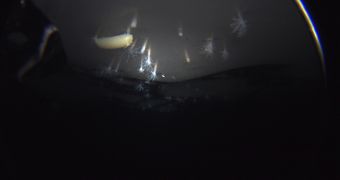An international team of experts working in the Antarctic Geological Drilling (ANDRILL) program announce the discovery of a new species of sea anemone. The creatures were discovered burrowed under the Ross Ice Shelf, in Antarctica, during the program's latest expedition to the Southern Continent.
The investigation was led by scientists from the University of Nebraska-Lincoln (UNL), who have used a robotic underwater vehicle to investigate the undersides of the massive ice shelf. The team was not expecting to find too many animals at this location, so the presence of these anemones surprised them.
While studying the ice shelf, the ROV detected protrusions extending from the ice mass, similar to tentacles, or flowers floating from a ceiling. Engineers were then able to set up a rig that enabled the expedition to collect some samples from this interesting population.
The animals were dubbed Edwardsiella andrillae, to honor the expedition. ANDRILL is funded by the US National Science Foundation (NSF), through its Coulman High project. Interestingly, the underside of the Ross Ice Shelf contained innumerable thousands of these creatures.
“The pictures blew my mind, it was really an amazing find,” comments Ohio State University sea anemones expert Marymegan Daly, who led a team that analyzed the sample retried from Antarctica. Details of the study were published in last month's issue of the open-access journal PLoS ONE.
The ANDRILL expedition that found the new anemones was conducted in late December 2010, but it was only last year that researchers were finally able to confirm that Edwardsiella andrillae was an entirely-new species. These are the first-known anemones to live inside ice, as opposed to the sea floor.
This discovery highlights the numerous species and phenomena that still await discovery at the South Pole, even after 50 years of continuous expeditions, comments the leader of the NSF Division of Polar Programs' (DPP) Antarctic Sciences Section, Scott Borg.
“It is an absolutely astonishing discovery – and just how the sea anemones create and maintain burrows in the bottom of the ice shelf, while that surface is actively melting, remains an intriguing mystery. This goes to show how much more we have to learn about the Antarctic and how life there has adapted,” the top NSF official commented.
The underwater autonomous robot that made this discovery managed to get under the massive ice shelf through a borehole the team drilled in the 270-meter (886-foot) thick ice mass. The machine itself was a 1.4-meter (4.5-foot) wide cylinder, outfitted with lateral- and front-facing cameras.
“People were literally jumping up and down with excitement. They had found a whole new ecosystem that no one had ever seen before. What started out as an engineering test of the remotely operated vehicle during its first deployment through a thick ice shelf turned into a significant and exciting biological discovery,” says the executive director of the ANDRILL Science Management Office at UNL, Franck Rack.

 14 DAY TRIAL //
14 DAY TRIAL //